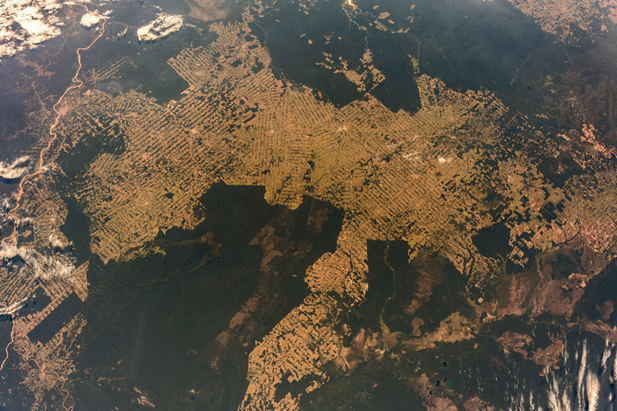
Figure 1: The sheer amount of deforestation of the Amazon rainforest is easily visible in satellite images, like the one shown above. Areas that are yellowed/light green are areas that previously were covered by dark green forest.
Image Citation: Wikimedia Commons
The environmental problems the world is facing don’t bring questions limited to the science of climate change and the future of the planet, but also extend to ethical concerns regarding indigenous land ownership. In the US, for example, Mark Zuckerberg, CEO and co-founder of Facebook, has been in hot water for the past few years over land disputes in Hawaii. In 2017, Zuckerberg sued native Hawaiians so that he could use their land on the island of Kauai to build a mansion. Though the lawsuit was later dropped, he has been accused of using local residents to sue on his behalf and is still currently dealing with media fallout from Native Hawaiians.1
Another battle ongoing just south of Hawaii in Brazil has been about regarding rights to ownership of the land of the Amazon rainforest. Over the past several years, the indigenous peoples of Brazil have been fighting against both federal and private deforestation of the Amazon rainforest.2 Despite their best efforts, deforestation of the forests has persisted; during the past year alone, over 3500 square miles of the Brazilian Amazon rainforest has been cleared away, a 34% increase in destruction from previous years.3 Besides having devastating impacts on the indigenous communities residing on the land, deforestation has significant negative effects on the environment. It can lead to soil erosion, desertification, flooding, animal extinction, as well as an increase in greenhouse gases in the atmosphere and a decrease in crops.4
Now, researchers from University of California, San Diego, have found that preserving the Amazonian Rainforest for Brazilian indigenous peoples significantly curbed deforestation. By utilizing satellite imaging data of the forest between the years 1982 and 2016, combined with federal records of Native land ownership, the team was able to determine that rates of deforestation in lands owned solely by indigenous peoples were lower by 66%.5
These findings have significant implications for the future of Amazon land ownership. Co-author and political science researcher Kathryn Baragwanath commented that besides being a human rights issue, giving land ownership to Native Brazilians is a “cost-effective way for governments to preserve their forested areas and attain climate goals.” 6 Because preserving land for indigenous peoples is far less expensive than undertaking massive environmental preservation efforts, it is easier for policy makers trying to curb climate change to fight for Native land rights. Additionally, activists for Native rights can use these findings to try to both stop deforestation and protect indigenous lands not just in the Amazon but worldwide.
References
[1] Froelich, P. (2020, July 4). Mark Zuckerberg accused of ‘colonizing’ Hawaiian island. New York Post. https://nypost.com/2020/07/04/mark-zuckerberg-accused-of-colonizing-hawaiian-island/.
[2] Spring, J. (2019, August 23). Brazil’s indigenous people swear to fight for Amazon ‘to last drop of blood’. Reuters. https://www.reuters.com/article/us-brazil-environment-wildfires-tribe/brazils-indigenous-people-swear-to-fight-for-amazon-to-last-drop-of-blood-idUSKCN1VD1WO.
[3] Mongabay. (2020, August 7). Amazon rainforest the size of Sao Paulo cleared in July in Brazil. Mongabay Environmental News. https://news.mongabay.com/2020/08/amazon-rainforest-the-size-of-sao-paulo-cleared-in-july-in-brazil/.
[4] Effects of Deforestation: The Pachamama Alliance. Pachamama Alliance. (2019). https://www.pachamama.org/effects-of-deforestation.
[5] Baragwanath, K., & Bayi, E. (2020). Collective property rights reduce deforestation in the Brazilian Amazon. Proceedings of the National Academy of Sciences, 201917874. https://doi.org/10.1073/pnas.1917874117
[6] University of California – San Diego. (2020, August 10). Indigenous property rights protect the Amazon rainforest. ScienceDaily. Retrieved August 12, 2020 from www.sciencedaily.com/releases/2020/08/200810160151.htm
Related Posts
Mind Missing Out? Fear of Missing Out and the Brain
Figure: A person scrolling through news articles on their smartphone....
Read MoreCOVID-19 and its Implications for Adolescent Mental Health
Covid 19 and Isolation (Source: created by author) Abstract The...
Read MoreThe Pathway to Sonogenetics: Understanding the Mechanical Nature of the Ultrasound Stimulation Mechanism in C. Elegans
Figure 1: C. elegans in Agar under Microscope Magnification Source:...
Read MoreAnahita Kodali



